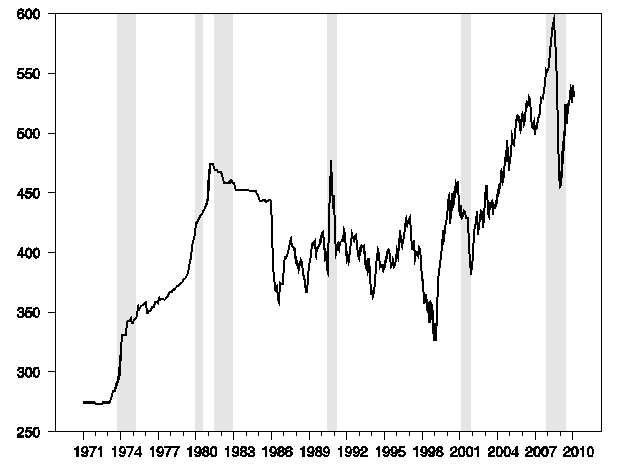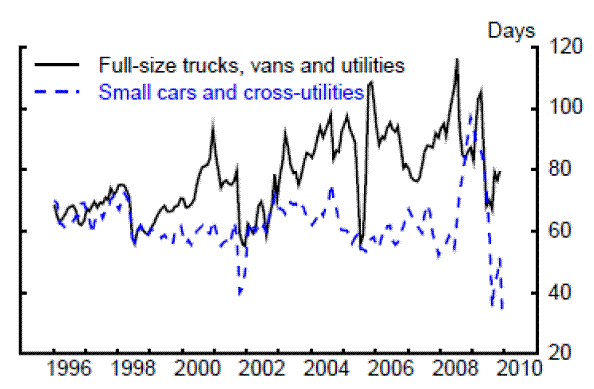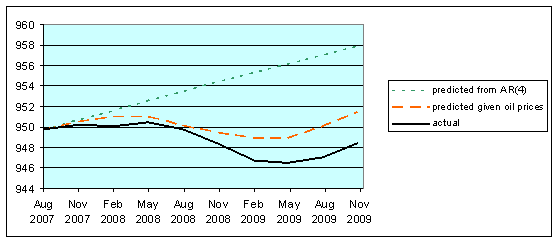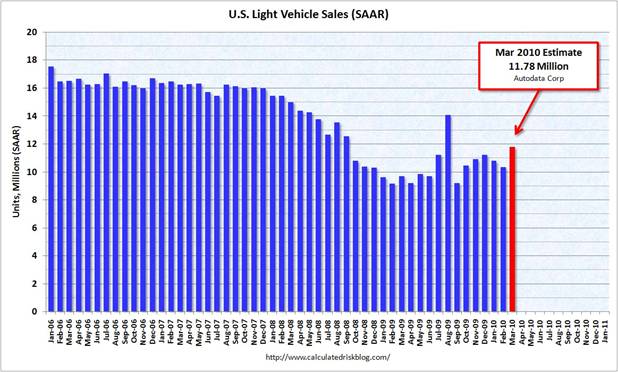Ten of the 11 recessions in the United States since World War II have been preceded by a sharp increase in the price of crude petroleum. Oil had been holding around $80/barrel over the last month, but traded as high as $87 last week, leading the Financial Times to ask whether oil could give the “kiss of death to recovery.” Here is how I would answer that question.
 |
Americans buy a little less than 12 billion gallons of gasoline in a typical month. With gas prices now about a dollar per gallon higher than they were a year ago, that leaves consumers with $12 billion less to spend each month on other things than they had in January of 2009. On the other hand, the U.S. average gas price is still more than a dollar below its peak in July of 2008. Changes of this size can certainly provide a measurable drag or boost to consumer spending, but are not enough by themselves to cause a recession.
 |
My view is that it is not just the level of consumer spending but also a sudden change in its composition that sometimes contributes to an economic recession. When oil price increases are sufficiently sudden and dramatic, we see abrupt drops in consumer sentiment, postponement of purchases of consumer durables, and important changes in the kinds of vehicles consumers buy. Because labor and capital can not costlessly shift out of the affected industries, the result is unemployment in those sectors which is an important additional factor bringing the economy down. UCSD Professor Valerie Ramey and Federal Reserve Economist Dan Vine have a very interesting new paper demonstrating how shifts in the demand for light vehicles contributed to the U.S. recession of 2007-2009 in a similar way to what we observed in earlier downturns.
 |
If these spending shifts are indeed an important part of the transmission mechanism, we would expect the economy to respond to changes in oil prices according to a nonlinear relation. A rise in oil prices may induce some consumers to postpone purchasing a car, but a fall in oil prices does not lead them to go out and buy two new ones. Moreover, an oil price decline can induce some other sectoral adjustments such as layoffs for those who work in the oil industry. I’ve recently completed a paper reviewing some of the academic literature in which I conclude that the empirical evidence for a nonlinear response is pretty compelling.
I’ve shared before with Econbrowser readers ([1],
[2]) the results if you use a particular nonlinear model that I first published in 2003 to forecast what real GDP would have done after 2007:Q3 conditional on knowing the subsequent path of oil prices. Here’s an update on how that forecast is doing when you match it up with the actual values for GDP that we saw in 2009:Q4. The downturn was more severe than could be attributed solely to the oil shock of 2007-2008, but that shock appears to have been an important contributing factor, and the overall path followed by GDP up to this point is very similar to the 2-year-ahead prediction. Note that according to this model, the economic growth now being observed is not due to the decline in oil prices after 2008:Q2, but is instead simply a result of a normal cyclical recovery as the economy eventually works through the adjustments to the initial shock.
 |
According to the relation that generated the above forecast, we wouldn’t have to worry about another oil shock until the oil price series in the top figure gets back above the values of 2008:M6 or until the 2008 highs recede farther into memory. I’m not comfortable taking that particular functional form too literally. As I noted in my original paper, lots of alternative nonlinear functional forms could also fit the historical data about as well. But I do have doubts that the mechanisms that were a factor in the first half of 2008 could operate with the same force in the current environment. I’m doubtful of a renewed plunge in light vehicle sales, in part because the levels are still so low and so many purchases are still being postponed.
< |
And with retail gasoline prices still a dollar a gallon below what consumers have recently seen, I’m doubtful that gasoline prices have the ability to induce as much consumer anxiety as we observed two years ago. Although recent increases in prices have brought energy expenditures back up as a share of total consumer spending, they’re still below the 6% level at which consumers historically have started to make dramatic adjustments.
 |
So to return to the question posed at the beginning: $87 oil is certainly not helping the recovery. But I would be very surprised if it proves to be the kiss of death.
Thanks for continuing to shed some light on this topic which gets relatively little play among other top economist blog sites.
So what price kicks us over that 6% level? $100 per barrrel, or a bit higher?
Thank you for a superb post. I would add that there currently appears to be little hand-wringing and teeth-gnashing going on with respect to fuel prices. Compare the current situation with all the hysteria and finger-pointing of 4 to 5 years ago.
In the language of the street, the public appears to be ‘capitulating’ as if these higher fuel prices were fully expected.
I have been pondering this myself, I wonder if a tweak to your model is required to adjust for collapsing consumer credit (the ability to draw on other dollar resuources other than income), taxes and health insurance. I believe the sensitivity to higher oil is going to evoke a political response at a far lower rate than in the past. This will affect economic growth as it will require the government to ratchet back ZIRP and QE to bring energy costs back into line.
So what price kicks us over that 6% level? $100 per barrrel, or a bit higher?
Posted by: Barkley Rosser at April 10, 2010 01:48 PM
Good question. Has anybody by chance worked out a quick ‘n dirty calculator that allows benchmark oil prices to translated into (a) the cost of regular gasoline at the pump (US$), and (b) GDP energy intensity? Care to share the toys?
Barkley and GNP: My rule of thumb is that $1/barrel for crude oil shows up as about 2.5 cents per gallon U.S. retail gasoline price. However, there’s not such a simple rule for going from WTI to the energy share. For one thing, the energy expenditure numbers are adjusted for seasonal factors. For another, there’s a trend in income. My guess, though, is that $100/barrel would be enough to push us back above 6%.
The public has bought into the peak oil scenario and has incorporated a path of increasing oil/gasoline prices into their expectations. The recent oil price increase is not sufficiently sudden and dramatic to significantly dampen the increasingly positive consumer sentiment.
Sorry, but you are missing one VERY important point here (as mowt economists did and still do):
the oil price rise in 2008 was fuel by debt and a consumer unwilling to retreat. Therefore the exponential spike in oil price and the following sudden implosion of it: credit made it feel comfortable until the WHOLE BUBBLE BURST! Then everyone panicked.
BUT NOW look at the oil price rise. It is not exponential, it is rather logarithmic. There is no credit buffer any more. DO *NOT* compare after the credit bubble burst with the time before it burst.
And it is not only the US consumer who is now out of credit. The whole world is suddenly facing a credit crisis where governments start to outcrowd the private sector. The hardly budging oil price contradicts the recovery slope. It is now pumped up by speculative dumb money following the last peak in 2008 (in contrast to 2008) while the front contracts are again depressed by 10% y/y and thereby indicate that spot pressure is pointing rigidly down while the speculators are hard to convince that oil prices are too high.
We’ll see. Germany has done a huge migration towards renewable energies during the last years. And so did many other western countries. And many will follow. Oil is not as necessary as many now seem to think….
Additionally, a lot of oil consumption growth comes from Russia, Mexico and the OPEC. That setup looks a lot like a leveraged bet on high oil prices where increasing domestic demand gets more and more funded by a diminishing oil export profit. This could get pretty ugly when thinking about the political consequences in many of these countries.
Thanks, Jim. That looks about right.
Seems to be some kind of disconnect here. In the recession of 2002, oil did get pretty low, under $20 a barrel and it did move up significantly into the $30’s in 2003, but we’re talking about over $80 a barrel now, and our economy is nowhere near the shape it was in 2003. We’re pushing 10% unemployment and starting an economic recovery at $80+ a barrel? I’m sorry, it looks like we’re stuffed.
Our whole economy is powered by the plutonomists so it really doesn’t’ matter what the effect on the peasants is. Can anyone remember 2005? The oil prices were really high and it had no effect on the economy. The top ten percent account for fifty three percent of the seventy percent consumer to GDP number and it takes a lot of fuel to move those goods. I refuse to be fooled anymore by retail numbers signaling a recovery for the “Second America”.
Professor Hamilton, thank you very much for your response to my query! This is a treasure trove of information.
It may be useful to compere this blog post with an online document by Steven Kopits, which unfortunately has the following very long URL: http://docs.google.com/viewer?a=v&q=cache:7P9dmoYg7eIJ:www.dw-1.com/files/files/438-06-09_-_Research_Note_-_Oil_-_What_Price_can_America_Afford_-_DWL_website_version.pdf+oil+consumption+U.S.+4%25+of+gdp&hl=en&gl=us&pid=bl&srcid=ADGEESinkbD0JcM91QZMxRX8YUOxnJjQIIhlu1wgadtmJu2StOlKnI8sG1uzcPYiQlSCXF5Y-ZhB_yvD3nzZcvVcR2trMTOAjiw07yzXaxj64WuhHUfMLqE1i0H57ZWvqHEKuVds-9wu&sig=AHIEtbT1jouUEPqPLnmma1QlHE4JtP1B2g
Kopits says that we have entered recession whenever energy prices have been over 4% of GDP *or* have gone up 50% a year or more. Of course, in 2009 they went up over 100% and we went from recession to recovery.
A better correlation might be 4% of GDP *and* a price move of 50% or more. Put another way, a very gradual price move, such as we have had since last June, causes consumers to alter their behavior in a way that results in a slowdown, not a recession, but enough of a slowdown that Oil consumption declines and Oil prices follow, having never crossed the 4% mark.
Have there been earlier periods that fit such a pattern? Maybe 2005-2006 is a candidate?
Sustained $85 oil may not bring us down, but there is no discussion here of why the price broke through it’s previous stable level and continues to rise.
Unfortunately, it is very hard to know precisely why this is happening, but cheap money spurring speculation, along with the OPEC cuts, appear to be the main factors. Most oil analysts, me included, have given up on the idea that fundamentals alone could explain the crazy price swings we’ve seen since 2005.
Since the price rise is divorced to some extent from fundamentals, there is no apparent brake on the price. We’ll see $3/gallon gasoline in early May (or sooner) and oil appears to be headed for $90+. In a very weak economy which is in circumstances (e.g. underemployment) never seen before in the historical time series since World War II, it is somewhat risky to model what might happen now based on that past experience.
As I wrote yesterday, I think sustained oil in the low $90s or above could be a real drag on the “recovery” this year. And we may see that price in a few weeks.
Dave,
Um, surging growth in Cbina? Apparent end of global recession with employment finally beginning to rise in the US and the Dow hitting 11,000 along with Iraq still not quite being ready to bring all those new fields into production that will offset the squeeze on the northern part of al Ghawar?
Well, either way the U.S. economy is doomed and the rest of the world will flourish. As long as other countries, especially OPEC and other oil-rich nations, trade their oil in U.S.-denominated dollars then they won’t get anywhere.
Iran was correct is banning the Dollar and using the Euro, which I believe they’ll dump too soon.
I read a comment on top stating that the DOW hitting 11,000 is a good thing. That’s wrong. So what if the DOW hits 11,000? It can go to 15,000 for all I care. The dollar is worthless and will forever be!
One last note, I’m always amazed at the American and Canadian perception of oil. When it’s in the news, people say its scarce but when it’s not then they are quite apathetic. Which is it?
P.S. Good article.
What am i missing I have this ratio already at 5.90% in February 2010
Bill: I just had the January numbers. Where’d you get the February data?
>> Does a dollar devaluation threaten the economic recovery?
There. Fixed the title for ya.
To bad we’re only around half way through this structural change, Prof. Remember our discussion
about parachute packing? The damage is done,
but most of the pain is packed into the event at
the end.
Ah, good ole Knot. What dollar devaluation? The one you think in your head?
The recovery looks about over. The next RE resets are set to ramp up and that is a bigger threat to any “recovery” than Commodities.
Other comments have mentioned a puzzle. The consumer began delevering in 2005, that is when household formation began to slow and when housing starts began to drop.
Yet, from 2005 – 2008 oil imports, by volume held high. I would like to know who was using all that oil.
Maybe the military, though the largest user of oil, they still only account for less than 2%. I have transportation at 60% of total, so that is mostly non-military commercial and personal transportation.
Why didn’t that demand fall as the user delevered from housing? Something deeper happened that made transportation more valuable relative to housing.
I’d say that the better question is: Does the pace of the recovery threaten the price of oil?
I suspect that the answer to that question is yes, and that commodity prices in general and oil prices in particular are due for a modest correction.
Global oil demand is stagnant and supplies are in balance, so supply and demand fundamentals are not likely driving a portion of the price. I suspect that part of the price is being created by speculation, just as it was during the height of the 2006-8 bubble.
We aren’t likely to return to back below the $30 level — it’s not as if the entire increase in oil prices is due to speculation. But oil in the $60-70 range would make more sense, given current conditions. A rapid recovery could sustain the current price, so a correction isn’t a sure bet, but a series of mildly disappointing economic news could be enough to let the air hiss out.
Next to gold oil is probably the most monetary commodity. That means that it is a leading indicator of monetary weakness. The professor’s analysis is spot on but not for the reasons he assumes. You have to push back and ask why did the price of oil increase or decrease. Most make the mistake of only looking at supply and demand but once again you have to push back.
Higher demand for oil for example during the prosperous years of the 1980s and 1990s actually brought out sufficient supply to satisfy demand even though it was booming. We did not have any oil crisis or price boom.
The primary factor driving the price of oil is monetary weakness or strength. The monetary strength of the late 1990s drove the price of oil down to the point of production and suppliers were just able to keep up with demand. Then the boom of 2000 with the huge rise in real estate that funded a buying binge (homes were everybodies ATM) caused demand to significantly out-run supply. Yes, high prices do create conservation and that is reflected in the price of oil moderating after 2008, but also note that the price of oil followed the price of gold.
Right now the price of oil is on the high end of its normal range relative to gold. Monetary measures and FED announcements lead us to believe that there will not be another huge injection of cash any time soon. That would lead me to believe that the price of oil will begin to moderate as soon as the gasoline peak is satisfied. Based on the current price of gold, oil should trade in a band slightly above $80/BBL.
Current pricees would seem to indicate that the professor’s factor to translate the price of a bbl of oil into the price of a gallon of gasoline is a little low. It appears that $0.03 is probably closer.
“Based on the current price of gold, oil should trade in a band slightly above $80/BBL. ”
Ricardo, what if the price of gold moves?
Thanks JDH.
For fun I went to newjerseygasprices.com and plugged in American average gas prices, Canadian average gas prices, as well as the price of crude oil for the 3-year time frame.
Note: I reckon the average pump prices are not weighted. The CL price is probably NYMEX WTI and not producer price data.
Please observe the following. Spot oil prices are currently higher and gasoline prices are currently lower than they were in mid-2007. What explains that? Tight refining margins?
Please note that Canadian prices given in US dollars are always about US$0.25/US gallon more in Canada than the USA. Excise taxes explain most of the gap.
On the baffling oil price rise —
Oil’s moves leave traders scratching their heads
And also see my post above
KevinM,
If the price of gold has a significant move then the price of oil would follow. That is why I mentioned the fact that it appears that the FED is slowing its monetary expansion. If the price of gold declines the price of oil would decline also, even if demand remains high. If the price of gold has another extreme runup then oil would also shoot up.
Because the price of oil is a leading indicator it actually functions more than a leading indicator. Because it reacts to monetary conditions it can race up ahead of other commodities and put downward pressure on production. In this sense I agree with the professor.
My forecast was based on the assumption that the money supply will remain relatively stable and the price of gold will not fluctuate significantly.
Dave Cohen,
If you understand the relationship between oil, gold and the dollar you will understand better the price of oil. For oil to rise to $90/bbl the price of gold would have to run up higher than $1,260. It topped out just a little above $1,200 in December and has since moderated to trade around the 1,110-20 range so it is doubtful that oil will rise above $90 and stay.
Gold has broken above the January highs and so we could see another surge but I don’t think the FED will repeat the past two years of expansion of the money supply.
But doesn’t the market and speculators predict the future, pricing the future into today’s price of oil??
Don’t investors use the market to predict the future demand and invest to deliver to meet demand or provide a substitute that will meet the demand?
I think a number of old large suppliers have either pursued production without looking to the future, say the US and Mexico, or are planning for the future like the Saudis and Chavez. Chavez has decided taking a bigger share and employing more citizens is worth more over the long term even if production is lower, especially when it pushes prices up. Saudi Arabia has cut back production to support price for over three decades (before that, the US did it at the Texas RR Commission).
I’d guess production will increase to keep the price in the $80-90 range. $3+ has become accepted and I’d be surprised if the Saudis let it go over $4 in the US. The price, the economy, and CAFE standards and green auto tax incentives are going to probably have the effect they had in the 80s, reduce gas demand. Lots of places are looking to replace oil heat with geothermal – green tax incentives help drive that. These are cumulative reductions in demand.
And we’ve had a decade of innovators looking for the next big thing now that “high tech” has shot its load in computers, cell phones, etc. Those who got their adrenalin shot in the 80s and 90s creating radical change are looking to do the same in green. The triple whammy of oil security, high oil prices, climate change have slowly built the foundations of a boom.
Auto replacement has been delayed. Factories closed and dismantled.
So, as the economy starts growing, lots of investment will be made in vehicles and capital equipment, with a lot going toward the green option. Higher oil prices would just ensure the demand shifts hard to green, out of fear if nothing else.
And that would create winners in the green sector.
And the non-green sector, the big houses, the gas guzzlers, aren’t going to drive the recovery as they have so many previous recoveries.
I think higher oil prices will produce more winners than losers, though the losers have been losing for two years and the recovery is only going to prolong the losing.
But higher energy costs have been making losers out of the rust belt for decades. After all, cleaning up the iron making was an energy issue. Detroit’s old car design was an energy issue.
mulp, CAFE isn’t likely to work too well since we’ve already picked the low fruit. About all we can do is reduce vehicle weights. And it also only works if people actually buy cars.
Those “green” taxes are anything but. Since started shooting up in 2004, fuel economy declined until well into the recession in 2008. We’re looking at the wrong end. The car isn’t what’s inefficient, it’s the transit system and the driver.
One of the EPAs most prominent pieces of advice for improving fuel economy is to avoid “aggressive driving”(http://www.fueleconomy.gov/Feg/driveHabits.shtml). While it is technically true that aggressive driving wastes fuel, it is important to distinguish aggressive braking and acceleration from brisk acceleration. The reality is that brisk acceleration is more fuel efficient than slow acceleration (http://autospeed.com/cms/title_Brake-Specific-Fuel-Consumption/A_110216/article.html)(http://www.nytimes.com/2001/06/07/technology/what-s-next-dashboard-miser-teaches-drivers-how-to-save-fuel.html?sec=&spon=&pagewanted=all). What causes aggressive driving to be inefficient is the tendency to accelerate too much and then need to slow down and accelerate again to get back up to speed. It’s not the acceleration; it’s the braking that wastes energy. In addition, slow acceleration decreases throughput at bottlenecks like intersections, greatly reducing fuel economy by increase stop-and-go traffic, the biggest detriment to good fuel economy. According to the Pakistan Energy and Environment Management Center, a full stop consumes up to 6 times as much fuel as moving stop (http://www.peemac.com/resource/fert/deet3.html)
During the past ten years, the fuel economy rating of our new vehicles has held steady and improved some (http://www.fueleconomy.gov/feg/feg2000.htm). Despite this and the fact that less efficient vehicles have largely sat in inventory since the precipitous rise in fuel prices beginning in 2005, the nations fuel economy has been declining (monthly data on vehicle miles traveled from the Federal Highway Authority http://www.fhwa.dot.gov/ohim/tvtw/tvtpage.cfm
, monthly data on gasoline consumption from the Department of Energy http://tonto.eia.doe.gov/dnav/pet/xls/pet_cons_psup_dc_nus_mbbl_m.xls).
While focusing on improving the fuel economy of individual cars, we have neglected the deterioration of efficiency of our overall transit system. It was not until the summer of 2008, after the start of the recession in 2007, that enough drivers left the road to recover some of the efficiency lost since 2005.
For those who question the relationship between gold and oil I suggest you look at a graph of the oil price and not its volitality before and after Richard Nixon took us off of the Bretton Woods standard.
Normally, as an oil and gas consultant, I would bite on a post like this, but I think it’s a meaure of oil prices that I don’t even have time to comment. Based on the deal flow we’re seeing, I’d describe the market as frothy.
How are we to get economic growth as net energy gain on oil keep falling with these rising prices? Is focusing on consumer attitudes toward prices really what should be done? At some point, the hard reality of less excess energy to fund the products of the modern way of life must come into view. It seems to me the stagnation in real wages over the last few decades and the huge increases in debt are actually epiphenomena in response to the lack of infinite hard resources to keep feeding the system. I think we need to focus on the bedrock of what economies actually run on, we need large scale investment in new ways of acquiring the energy a complex society runs on, or else its just a waiting game of bailing the boat as long as you can.
Unfortunately, it is very hard to know precisely why this is happening, but cheap money spurring speculation, along with the OPEC cuts, appear to be the main factors. Most oil analysts, me included, have given up on the idea that fundamentals alone could explain the crazy price swings we’ve seen since 2005. -David Cohen
I agree with your assessment of the main factors. However, I also believe oil in 2008 was trading mostly on traditional fundamentals. It is only as of 2009 that other factors seem to enter.
There is one factor you and everybody else are overlooking, and empirically, it may not be that significant: Israel’s regional nuclear weapons monopoly. The USA is willing to pay dearly in order to assure Israel’s regional monopoly. Many in both the USA and Israel seem to believe that nuclear weapons are necessary in order to help Israel continue to appropriate land and resources taken from folks living in what was left of the Palestinian mandate pre-1967 occupation.
Iran’s nuclear energy program could produce sufficient enriched material for a bomb or two, and who knows, the Iranians may eventually acquire credible vectors to deliver those bombs. I do not pretend to understand Iran’s motives. I view nuclear weapons as a dangerous, costly vanity asset if looked at from the perspective of assuring security for medium- and small-nation states. Israel, for example, would be strategically better off if it unilaterally disarmed itself. That said, the proliferation treaty is in shambles, a tragic joke really. Somewhere between Canada, France and the USA, western nations have gifted nuclear bombs to India, Israel and Pakistan. Given Israel’s chronic disrespect for international law, I suppose one can come up with reasons why Iran might wish to acquire nuclear weapons, even if the strategy looks counter-productive upon closer examination.
Moreover, it seems that Israel continues to drive US Mid-East policy. So one might expect buyers, speculators, and traders in the oil markets to place a hefty positive probability on Israel bombing Iran, and Iran retaliating by closing of the Straits of Hormuz. Oil prices would sharply increase well past US$100/b in such an event. US GDP growth would likely turn negative and thus help reduce growth in global oil consumption. But I doubt markets are looking out that far ahead.
James Hamilton
I am curious about your usage, should you not be saying
‘non symmetric’ rather than ‘non linear’ ?
It’s not that the economic response to an energy price move is not linear (it’s a curve) but that it is different down rather than up in the oil price?
There are analogies here to sticky wages and sticky prices.
Valuethinker: Most of the literature has followed your preference and used the term “asymmetric” rather than “nonlinear”. My view is that “symmetric” could naturally be interpreted as a quadratic rather than a linear function. The question is whether the underlying relation is linear in logs (see discussion in my recent paper).
Isn’t it reasonable to expect a little oil price inflation since we’ve almost doubled the money supply in the last 10 years? Is that altogether a bad thing, or just a sign that people are actually spending money now and some of it makes its way to oil?